THE INCREDIBLE POWER OF
SPLIT-SECOND LIGHTNING
Western York County, South Carolina--where Hilton Pond Center is located--has interesting and sometimes unpredictable weather. About ten miles northwest is a range of low mountains that, we are (almost?) convinced, alters the movement of storm fronts such that locations just to the east and west of us often get torrential rainfall while the sun is reflecting off Hilton Pond. We described this mysterious (imaginary?) phenomenon--which we refer to as the "King's Pinnacle Effect"--in an earlier posting, and have heard from no one who suggests our hypothesis is invalid (or valid, for that matter). The effect doesn't always seem to work, however, and this week (10 May 2005) Kings Pinnacle actually seemed to attract rather than repel a series of powerful thunderstorms that bore down on the Center with amazing force. That day began with cool temperatures and sunny skies that continued through lunch, but by 2:30 p.m. or so storm clouds on the near horizon began to darken ominously. As we sat at our west-facing computer desk at the Center's old farmhouse, we could watch the front approaching with pretty good speed, and we could also hear increasingly frequent claps of thunder as the clouds got closer and closer. We enjoy thunderstorms and were pleased to have a front-row seat for this one as lightning flashed and a low rumble followed several seconds later. Wind-driven rain began to whip across the property and suddenly there was a brilliant flash of light, followed instantaneously by a enormously loud crack of thunder. We knew something very close to us had just been struck with the incredible power of a split-second of lightning.

All text & photos © Hilton Pond Center
We aren't normally startled by loud or strange noises, but this back-to-back lightning strike and thunderclap made us jump. We recovered quickly, however, and after the initial "HOLY Cow!" our next utterance was "Uh-oh," for we knew that something at or very near Hilton Pond Center had been the target of this lightning strike. Our suspicion was quickly verified when we noticed air moving around our ankles--a gentle breeze created when the furnace blower came on, even though the furnace was off. Our quick diagnosis was that a switch or circuit board on the furnace had gotten fried by the electrical impulse. After turning off the fan at the breaker box, we quickly turned attention to our Macintosh computer, a device whose best friend would NEVER be a power surge caused by lightning. We figured the computer itself was safe--it stays connected to a substantial battery back-up system--but all our peripherals are connected to smaller surge protectors that a near-direct lighting hit might easily overpower. Sure enough, the icon for a 250-gigabyte external hard drive disappeared from our computer screen, which likely meant it, too, had gotten fried.

All text & photos © Hilton Pond Center
In an effort to find out how much longer we might have to contend with this damaging thunderstorm, we started our Web browser and tried to log onto weather.com. We never got there, however, because the unmistakable odor of an electrical fire was beginning to permeate our workspace. We glanced at the cable modem to see that all its lights were out, and our nose told us the modem box was the source of the acrid smell. Obviously, the cable modem was REALLY fried, so we knew we wouldn't be doing any more Web surfing until the phone company came out and replaced our now-useless modem. Thus, we returned to gazing out the window. Eventually the lightning abated, but rains continued until supper time, when another wave of less-destructive thunderstorms came through and lasted until well after dark. The intensity of the on-going storms is documented by hundreds of lightning strikes on a Charlotte regional map (above), supplied to Hilton Pond Center by meteorologist Al Conklin of WBTV in Charlotte.

All text & photos © Hilton Pond Center
Our first task the next day was to find where that high-powered lightning jolt had struck the afternoon before. Joined by brother-in-law Wes Ballard, who had come to visit from Greenville SC, we wandered outside on soil still-soggy from the inch of rain that had fallen the preceding day and overnight. A few yards down the trail Wes yelled something along the lines of "Woo, Doggie," a politically correct Southern epithet that implied he had just located the lightning strike. Sure enough, right at the edge of the pond about 75 feet from our office window, stood a giant and beloved White Oak with a garish new decoration on its trunk--a rusty-red eight-inch-wide gash that ran from ground level until it disappeared into the leafy canopy 60 feet above our heads. This massive oak tree now bore a scar so massive it could have been caused only by a massive lightning bolt.
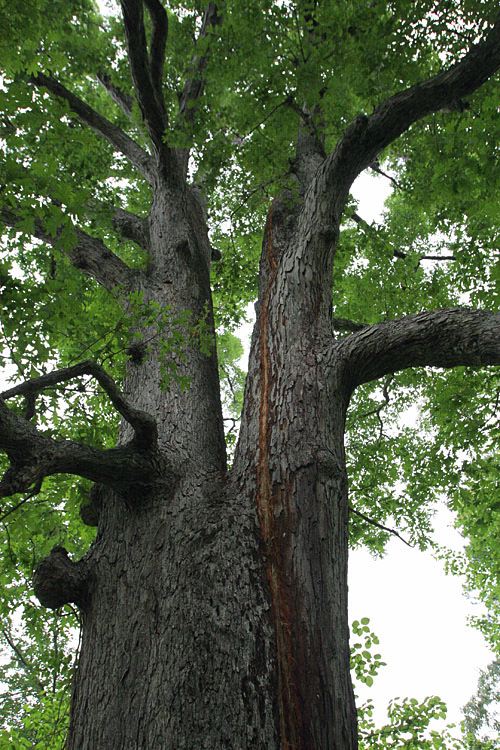
All text & photos © Hilton Pond Center
We stood speechless at the base of this giant oak, our eyes repeatedly tracing the path of the scar up and down the tree's trunk. It's difficult to relate in words or photo just how big this oak actually is--you have to hug it to truly understand--and it was equally hard to comprehend how powerful lightning must be for it to do this kind of damage. "Woo, Doggie," indeed.
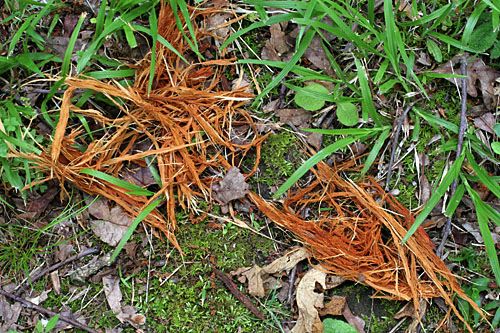
All text & photos © Hilton Pond Center
As we looked around a bit more, we found wads of what looked like yellow-red spaghetti scattered around the tree (above); not pasta, these were pieces of wood that exploded off the tree when lightning struck. Apparently, water in the wood was instantly brought to boil by the electrical current, blowing shredded wood and chunks of bark 50 feet or more from the oak itself. Now THAT is some kinda power! 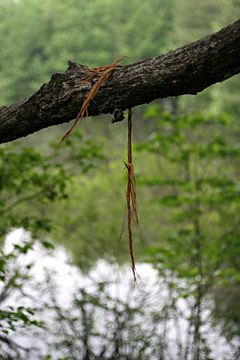 Debris littered the ground beneath the oak, floated on Hilton Pond itself, draped on leaves and branches of other trees and shrubs, and made us wonder what would have happened had one of those pieces of lightning-propelled bark hit a window--or our forehead. Debris littered the ground beneath the oak, floated on Hilton Pond itself, draped on leaves and branches of other trees and shrubs, and made us wonder what would have happened had one of those pieces of lightning-propelled bark hit a window--or our forehead.
Judging from its size, this venerable White Oak, Quercus alba, is probably at least 125 years old years. Using a forester's measuring tape, we found the tree to be 15 feet in circumference and 58 inches dbh (diameter at breast height)--almost five feet across. Although other measurements are made difficult by surrounding trees, we estimate the oak to be 120 feet tall with a spread of perhaps 80 feet or so. Perched on the bank of Hilton Pond, this magnificent tree towers above all other vegetation on our 11 acres and understandably attracted lightning during the recent storm. It's the largest White Oak we've ever seen but, to be honest, it may actually be TWO trees that grew from a common rootstock and eventually merged, with the two trunks now joined about 20 feet above the ground. 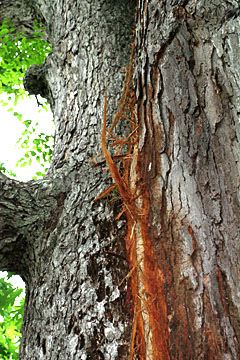 The lightning damage affected the more easterly half of the oak. (Incidentally, there's a Muskrat den in the pond bank just below where the lightning scar stops. We can't help but wonder what impact the strike may have had on these aquatic critters; if nothing else, we'll bet they had ringing in their furry little ears.) The lightning damage affected the more easterly half of the oak. (Incidentally, there's a Muskrat den in the pond bank just below where the lightning scar stops. We can't help but wonder what impact the strike may have had on these aquatic critters; if nothing else, we'll bet they had ringing in their furry little ears.)
It's easy to judge the immediate results of the lightning strike: It blew the heck out of wood and bark on the big oak tree and made a shambles of several electrical devices in the old farmhouse. (We're not having much luck with equipment at the Center as of late, what with our Canon digital SLR camera and lens getting crushed last week and now the sudden demise of the furnace, hard drive, and cable modem, and--it appears--a slowly dying main computer.) What's impossible to know is the long-term impact of a lightning bolt on the tree itself. Every day we go out with fingers crossed that none of the leaves on the tree's east side have wilted or turned brown.
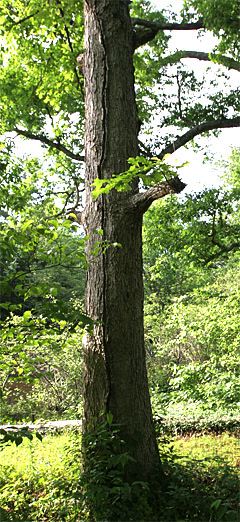 It's possible tree damage will be limited just to the region of the trunk immediately adjacent to the lightning scar, and that the oak will heal its wounds. That's apparently what happened to a smaller White Oak not far from the big one. Probably a daughter of the older tree, this younger oak is "only" 20 inches dbh with a 5-foot circumference. When we moved in 1982 to what is now Hilton Pond Center, the smaller tree had a vertical scar at least half the width of its trunk that could only have come from a recent lightning strike. Today, the younger tree's lightning scar is completely healed over (left), save for a small section just above ground level. We thought surely this tree would die from its electrical calamity but it surprised us with its resilience. It's possible tree damage will be limited just to the region of the trunk immediately adjacent to the lightning scar, and that the oak will heal its wounds. That's apparently what happened to a smaller White Oak not far from the big one. Probably a daughter of the older tree, this younger oak is "only" 20 inches dbh with a 5-foot circumference. When we moved in 1982 to what is now Hilton Pond Center, the smaller tree had a vertical scar at least half the width of its trunk that could only have come from a recent lightning strike. Today, the younger tree's lightning scar is completely healed over (left), save for a small section just above ground level. We thought surely this tree would die from its electrical calamity but it surprised us with its resilience.
We're hopeful Hilton Pond Center's magnificent methuselah White Oak (1985 photo below) will also rebound from this week's jolt and grow new wood across what currently is a significant gaping wound. We don't want to lose this towering oak--or even half of it--and we'd like to be able to say in 20 or so years that it, too, was able to heal itself despite the incredible power of a split-second of lightning.
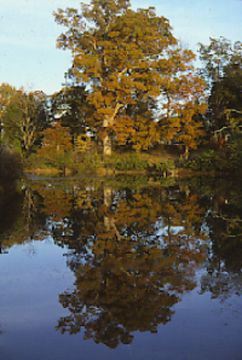
All text & photos © Hilton Pond Center
Comments or questions about this week's installment?
Please send an E-mail message to INFO.
 Be sure to scroll down for an account of all birds banded or recaptured during the week, plus other nature notes of interest. Be sure to scroll down for an account of all birds banded or recaptured during the week, plus other nature notes of interest.
"This Week at Hilton Pond" is written & photographed
by Bill Hilton Jr., executive director of
Hilton Pond Center for Piedmont Natural History.
You may wish to consult our Index of all nature topics covered since February 2000. You can also use the on-line Search Engine at the bottom of this page.
For a free, non-fattening, on-line subscription to "This Week at Hilton Pond," just send us an E-mail with SUBSCRIBE in the Subject line. Please be sure to configure your spam filter to accept E-mails from hiltonpond.org.
|






 Debris littered the ground beneath the oak, floated on Hilton Pond itself, draped on leaves and branches of other trees and shrubs, and made us wonder what would have happened had one of those pieces of lightning-propelled bark hit a window--or our forehead.
Debris littered the ground beneath the oak, floated on Hilton Pond itself, draped on leaves and branches of other trees and shrubs, and made us wonder what would have happened had one of those pieces of lightning-propelled bark hit a window--or our forehead. The lightning damage affected the more easterly half of the oak. (Incidentally, there's a Muskrat den in the pond bank just below where the lightning scar stops. We can't help but wonder what impact the strike may have had on these aquatic critters; if nothing else, we'll bet they had ringing in their furry little ears.)
The lightning damage affected the more easterly half of the oak. (Incidentally, there's a Muskrat den in the pond bank just below where the lightning scar stops. We can't help but wonder what impact the strike may have had on these aquatic critters; if nothing else, we'll bet they had ringing in their furry little ears.) It's possible tree damage will be limited just to the region of the trunk immediately adjacent to the lightning scar, and that the oak will heal its wounds. That's apparently what happened to a smaller White Oak not far from the big one. Probably a daughter of the older tree, this younger oak is "only" 20 inches dbh with a 5-foot circumference. When we moved in 1982 to what is now Hilton Pond Center, the smaller tree had a vertical scar at least half the width of its trunk that could only have come from a recent lightning strike. Today, the younger tree's lightning scar is completely healed over (left), save for a small section just above ground level. We thought surely this tree would die from its electrical calamity but it surprised us with its resilience.
It's possible tree damage will be limited just to the region of the trunk immediately adjacent to the lightning scar, and that the oak will heal its wounds. That's apparently what happened to a smaller White Oak not far from the big one. Probably a daughter of the older tree, this younger oak is "only" 20 inches dbh with a 5-foot circumference. When we moved in 1982 to what is now Hilton Pond Center, the smaller tree had a vertical scar at least half the width of its trunk that could only have come from a recent lightning strike. Today, the younger tree's lightning scar is completely healed over (left), save for a small section just above ground level. We thought surely this tree would die from its electrical calamity but it surprised us with its resilience. 


 Please report your
Please report your
